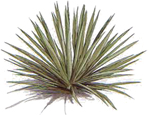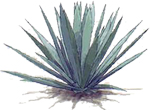Agave Spirits - Part II: The Species
Whereas with tequila the standards and practices of the spirit demand that all producers use Agave Azul (or blue agave) for their production, the mezcales producers of Oaxaca are free to use whichever species are at their disposal. What are the differences between these plants and how do they impact flavor, you ask? Me too!
Luckily my friend Jake Lustig sent me this chart after we got off the phone yesterday. Does anyone remember the old children's scientific book series called Golden Guides? I used to have every single one of these! I used to devour them as a kid. Jake's chart looks just like the one about cacti--with it's old school drawings in place of modern photography. Have a gander:
Espadín

- In Oaxaca, regarded as best flavor for growth time
- 7 years to harvest
- 80 kgs
- Widely cultivated
Arroqueño (has a light, bee-honey sweetness)

- In Oaxacan central valleys, regarded as best sweetness
- 10 years to harvest
- 180 kgs
- Not-cultivated
Cirial (has a slight sour sweetness)

- madrecuishe, bicuixe, etc… elongated shape
- 14 years to harvest
- 60 kgs
- Not-cultivated

- Long and fat shape
- 10-12 years to harvest
- Up to 340 kgs
- Cultivatable, easy to grow
- Ejutla, Monte de Toro
Sierrudo (a slight sour sweetness)

- Long-living, large size capability
- 16-20 years to harvest
- 450 kgs
- Not-cultivated
Mexicano (sweet with a bit of bitterness)

- Smaller version of Sierrudo
- 10 years to harvest
- 100 kgs
- Not-cultivated
Papalomé

- Colloquially called Bilíah
- 12 years to harvest
- 25 kgs
- Not-cultivated
Tovalá (also spelled Tobalá)

- 12 years to harvest
- 25 kgs
- Not-cultivated
Tepeztate

- Colloquially called Vequela
- Not-cultivated
- From Mixteca, used for aromatic flowers during Semana Santa
- Not used in Oaxacan central valleys
-David Driscoll
